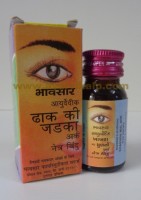Glaucoma and Ayurvedic Medicine: A Holistic Approach for the United States
Glaucoma is a chronic eye condition characterized by increased intraocular pressure (IOP) that can lead to optic nerve damage and vision loss if not managed properly. While conventional treatments such as medications, laser therapy, and surgery are common in managing glaucoma, many individuals are exploring complementary and alternative approaches, including Ayurvedic medicine, for managing this condition. Ayurveda, an ancient Indian system of medicine, offers various herbal remedies, dietary guidelines, and lifestyle practices that can potentially support eye health and overall well-being. This article delves into Ayurvedic treatments for glaucoma and their relevance in the United States.
Ayurveda and Eye Health
Ayurveda, which translates to the "science of life," is a holistic healing system that aims to balance the body's doshas (Vata, Pitta, and Kapha) to promote overall health. In Ayurveda, the eyes are considered a key sense organ governed primarily by the Pitta dosha, which is associated with heat and metabolism. Imbalances in Pitta, along with other doshic disturbances, are believed to contribute to eye disorders, including glaucoma.
Ayurvedic Perspective on Glaucoma
In Ayurveda, glaucoma can be understood through the concept of "Adhimantha," a condition characterized by severe eye pain, redness, headache, and vision disturbances. The condition is thought to arise from an imbalance in the Vata and Pitta doshas, leading to impaired circulation and fluid accumulation in the eye, causing increased intraocular pressure.
Ayurvedic treatment for glaucoma focuses on balancing the doshas, improving circulation, and supporting overall eye health. This is achieved through a combination of herbal remedies, dietary recommendations, eye exercises, and lifestyle practices.
Ayurvedic Herbal Remedies for Glaucoma
Several Ayurvedic herbs are traditionally used to support eye health and may have potential benefits for managing glaucoma. Here are some notable herbs and formulations:
1. Triphala
-
Benefits: A blend of three fruits—Amalaki (Emblica officinalis), Haritaki (Terminalia chebula), and Bibhitaki (Terminalia bellirica)—Triphala is renowned for its detoxifying and rejuvenating properties. It is believed to support healthy circulation and reduce oxidative stress, which is beneficial for maintaining eye health.
-
Usage: Triphala is typically consumed as a powder or tablet. It can also be used as an eye wash when mixed with water, though this should be done under professional guidance.
2. Maha Triphala Ghrita
-
Benefits: This is a medicated ghee (clarified butter) preparation that combines Triphala with other herbs. It is traditionally used to enhance vision and reduce eye strain.
-
Usage: Maha Triphala Ghrita is usually taken orally, often mixed with warm water or milk. In some Ayurvedic practices, it may also be used as an eye drop, but this should only be done under the supervision of a qualified practitioner.
3. Shatavari (Asparagus racemosus)
-
Benefits: Shatavari is known for its cooling and nourishing properties, making it beneficial for balancing Pitta dosha and supporting overall eye health.
-
Usage: It is available in powder, tablet, or liquid extract forms and is typically taken with milk or warm water.
4. Saptamrita Lauh
-
Benefits: A traditional Ayurvedic formulation containing Triphala, iron (Lauh bhasma), and other ingredients, Saptamrita Lauh is believed to support eye health and improve vision.
-
Usage: Usually consumed in tablet form, this formulation is recommended to be taken with honey or ghee.
5. Ashwagandha (Withania somnifera)
-
Benefits: Known for its adaptogenic properties, Ashwagandha helps in reducing stress and improving circulation, which may indirectly benefit eye health by reducing intraocular pressure.
-
Usage: Available in powder, capsule, and tablet forms, Ashwagandha is typically taken with milk or water.
Dietary Recommendations
Ayurveda emphasizes the role of diet in maintaining overall health and preventing disease, including eye conditions like glaucoma. The following dietary guidelines are recommended:
-
Include Cooling and Hydrating Foods: Incorporate foods like cucumbers, leafy greens, and melons to help balance Pitta and keep the body hydrated.
-
Consume Antioxidant-Rich Foods: Berries, leafy greens, carrots, and sweet potatoes are rich in antioxidants like beta-carotene, which support eye health.
-
Limit Caffeine and Spicy Foods: These can aggravate Pitta dosha and potentially increase eye pressure, so they should be consumed in moderation.
-
Increase Omega-3 Fatty Acids: Flaxseeds, walnuts, and fatty fish are good sources of omega-3s, which have anti-inflammatory properties and support eye health.
-
Stay Hydrated: Proper hydration is essential for maintaining healthy eye pressure, so drinking adequate water throughout the day is crucial.
Lifestyle Practices for Eye Health
In addition to herbal remedies and dietary adjustments, Ayurveda recommends several lifestyle practices to support eye health and manage conditions like glaucoma:
1. Eye Exercises
-
Palming: Rub your palms together to generate heat and gently cup them over your closed eyes. This practice helps relax the eye muscles and soothe the eyes.
-
Trataka (Candle Gazing): Focus on the flame of a candle placed at eye level until your eyes begin to water. This exercise is believed to improve focus and strengthen the eye muscles.
2. Stress Management
-
Meditation and Pranayama: Regular practice of meditation and breathing exercises helps reduce stress, which can contribute to elevated intraocular pressure.
-
Yoga: Incorporate gentle yoga poses like forward bends and inversions that promote blood flow to the head and eyes.
3. Sleep and Rest
-
Adequate Sleep: Ensure sufficient sleep to allow the eyes to rest and recover.
-
Eye Rest: Take regular breaks from screens and other activities that strain the eyes.
4. Protective Measures
-
Sunglasses: Wear UV-protective sunglasses when outdoors to protect the eyes from harmful rays.
-
Avoid Eye Strain: Reduce screen time and use proper lighting to avoid straining the eyes.
Integration of Ayurveda in the United States
Ayurveda is gaining traction in the United States as a complementary approach to health and wellness. Many Ayurvedic products, including herbs and formulations for eye health, are now available through health food stores, online retailers, and Ayurvedic practitioners. While Ayurvedic treatments for glaucoma can offer supportive benefits, they should be used in conjunction with conventional medical care, not as a replacement.
Healthcare providers in the U.S. are increasingly open to integrating Ayurvedic practices with conventional treatments, recognizing the potential benefits of a holistic approach to managing chronic conditions like glaucoma.
Precautions and Consultation
While Ayurvedic remedies offer promising benefits, it is essential to approach them with care:
-
Consult a Healthcare Provider: Always consult with an ophthalmologist and a qualified Ayurvedic practitioner before starting any new treatment, especially if you have glaucoma or other eye conditions.
-
Ensure Quality: Use high-quality, certified Ayurvedic products from reputable sources to avoid contaminants and ensure efficacy.
-
Monitor Progress: Regularly monitor your eye health and intraocular pressure, and keep your healthcare providers informed of any new treatments you are trying.
-
Complementary, Not Primary: Ayurvedic treatments should complement, not replace, conventional treatments prescribed by your healthcare provider.
Conclusion
Ayurvedic medicine offers a holistic approach to managing glaucoma through a combination of herbal remedies, dietary adjustments, eye exercises, and lifestyle practices. As interest in natural and integrative medicine grows in the United States, these ancient practices are being embraced by more individuals seeking to enhance their eye health. However, it is crucial to approach Ayurvedic treatments responsibly, with guidance from healthcare professionals, to ensure safe and effective management of glaucoma. By combining the wisdom of Ayurveda with modern medical care, individuals can take a proactive role in preserving their vision and overall well-being.
Disclaimer: This article is for informational purposes only and does not constitute medical advice. Always consult with a qualified healthcare provider before starting any new treatment regimen.










